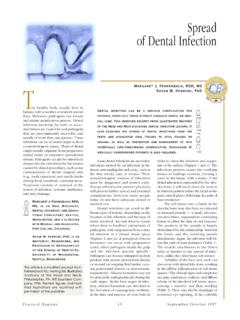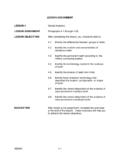Transcription of ©2014 JCO, Inc. May not be distributed without …
1 689 VOLUME XLVIII NUMBER 11 2014 JCO, D. KRAVITZ, DMD, MSTreatment with the mandibular arnold ExpanderDr. Kravitz is a Contributing Editor of the Journal of Clinical Orthodontics; an adjunct faculty member, Department of Ortho dontics, Washington Hospital Center, Washington, DC; and in the private practice of orthodontics at 25055 Riding Plaza, Suite 110, South Riding, VA 20152; e-mail: crowding otherwise referred to as tooth-size/arch-length discrepancy (TSALD) is the most common component of malocclusion among orthodontic patients. According to the Na-tional Center for Health Statistics, 40% of preado-lescent children and 85% of adolescents exhibit ,2 Particularly prevalent in the mandibular arch, it is often the determining factor in the deci-sion whether to extract of crowding is more challenging in the lower arch than in the upper arch because of the absence of a midline suture and the resistance of the mandibular body.
2 Any attempt to achieve sub-stantial mandibular dental expansion with fixed appliances can result in undesirable incisor and canine proclination outside the supported bony housing, which can strain the periodontium, alter the occlusion, and increase the potential for re-lapse. Therefore, the pretreatment mandibular intercanine width has been considered an invio-lable increases in mandibular inter-canine width may be possible, however, if expan-sion is begun prior to the eruption of the perma-nent ,8 This article describes the use of the arnold expander* also known as the expan-sion arch or E-arch as a means of mandibular expansion in patients with moderate TSALD. Al-though the mandibular arnold expander is most commonly applied during early interceptive treat-ment, its use during late adolescence will also be DesignThe arnold appliance is a fixed, coil-spring device that was popularized by Berkowitz in the 1970s as a way to produce slow, orthopedic maxil-lary expansion in cleft-palate In the man-dibular arch, the arnold appliance can open 4-5mm of space through tipping of the buccal teeth and distalization of the first molars10 (Fig.)
3 1).The device has a split lingual frame an .040" tube on one side and a wire insert on the other connected by an .010" .040" Elgiloy** or nickel titanium open-coil spring. Seating the appliance compresses the spring and activates it for expansion. Because there is no need to turn an expansion key or make any further adjustments, the arnold appliance is ideal for anxious patients Fig. 1 mandibular arnold expander produces 4-5mm of transverse dental expansion, mostly in canine and premolar regions.*AOA Orthodontic Appliances, Sturtevant, WI; **Registered trademark of Rocky Mountain Orthodontics, Denver, CO; 2014 JCO, Inc. May not be distributed without permission. 2014 treatment with the mandibular arnold Expanderor when parental participation is a distal arms of the expander are nor-mally soldered to bands on the mandibular first permanent molars. If these teeth have not fully erupted, the appliance can be fitted to the second deciduous molars; in that case, the laboratory tech-nician should be instructed to add lingual exten-sion arms to the first permanent molars, allowing simultaneous expansion of the posterior teeth.
4 Since I often use the arnold expander in conjunc-tion with full fixed appliances, I also ask the tech-nician to keep buccal tubes on the molar bands. A mandibular 2 4 appliance with a continuous archwire can correct malocclusions associated with TSALD, including incisor rotations, deep overbite, anterior crossbite, and tooth impaction due to premature exfoliation of the mandibular deciduous the desired expansion has been achieved, the appliance is made passive in one of two ways: pinching the .040" tube firmly against the wire insert with a heavy-wire cutter (Fig. 2A) or cutting through the open-coil spring while keeping the frame intact. Either method essen-tially converts the appliance into a holding arch. The passive arnold expander can be left in place until the eruption of the mandibular second pre-molars or the start of Phase II treatment . If the appliance causes pain by embedding in the lingual tissue, becomes covered with calculus, or impedes the eruption of a tooth, I remove the lingual frame by sectioning the expander mesial to the first mo-Fig.
5 2 A. Appliance deactivated by pinching tube firmly with heavy-wire cutter. (Alternative is to cut through open-coil spring, leaving frame intact.) B. Appliance removed by sectioning lingual frame mesial to first molar, using No. 557 crosscut-fissure carbide 3 Dr. James Thacker s variation on tradition-al mandibular arnold expander, with deciduous-molar occlusal rest and mesial stop for open-coil spring (appliance fabricated by AOA Labs).Fig. 4 Lingual frame of expander has lifted above occlusal table, resulting in molar distalization rather than transverse 691 VOLUME XLVIII NUMBER 11 Kravitzlar with a No. 557 crosscut-fissure carbide bur (Fig. 2B).An alternative developed by Dr. James Thacker incorporates two additional features: an occlusal rest for the first deciduous molar, on the side opposite the open-coil spring, and a stop for the spring (Fig. 3). Since some patients have a tendency to lift the lingual frame by pulling on it with their fingers or repeatedly flicking it with the tongue, the occlusal rest prevents the expander from rising above the occlusal table, where it might impede dental eruption and result in molar distal-ization rather than transverse dental expansion (Fig.)
6 4). To prevent further lifting, the wire side of the frame can be bonded to the left deciduous ca-nine with flowable composite. Securing the appli-ance on one side will not affect the symmetry of expansion, but will impede molar distalization on the bonded side. Placing the stop mesial to the first molar on the spring side of the appliance makes it easier to section the lingual frame for removal, and it also keeps the spring from irritating the patient when the frame is Insertion and ActivationBefore inserting the arnold expander, wrap an orthodontic elastic around the lingual frame to compress the coil spring and keep the two sections of the appliance together. Holding the molar band with the fingers, bend the frame slightly downward with a Weingart plier to help prevent it from rising above the occlusal surface during expansion (Fig. 5A). Seat the appliance with the elastic still tightly wrapped around the lingual frame (Fig.
7 5B), then remove the elastic with a pin-and-ligature arnold expander should be activated for nine to 12 months, depending on the severity of crowding. Most patients will also need a rapid maxillary expander (RME) in the upper arch; the arnold appliance establishes a reference man-dibular arch width to guide the maxillary expan-sion. Since the RME may need to be reactivated for arch coordination, I do not remove the expand-er or seal the expansion screw until satisfactory mandibular expansion has been 1 (Preadolescent)A 7 -year-old male presented with a Class I skeletal relationship. The patient displayed maxillomandibular transverse constriction, a 1mm overbite, severe crowding, an unerupted upper right central incisor, and impacted upper and low-er lateral incisors (Fig. 6). He had been diagnosed with hemophilia A, which was being treated with desmopressin to stimulate the release of von Wil-lebrand factor. In collaboration with his physician, we presented a plan for 18 months of Phase I treat-ment with a banded maxillary Hyrax-type RME and a removable mandibular Schwarz appliance, followed by anterior fixed three months of failed compliance with the Schwarz appliance, the parents opted for a fixed arnold expander.
8 Eight months later, the dental expansion had allowed complete eruption of the lower lateral incisors (Fig. 7). Due to the Fig. 5 A. Frame bent slightly downward with Weingart plier before appliance insertion. B. Frame inserted, with elastic holding two seg-ments 2014 treatment with the mandibular arnold Expanderin place until the eruption of the lower second premolars (Fig. 8).Case 2 (Late Adolescent)A 14-year-old male presented with a Class I skeletal relationship. Clinical examination indi-cated excessive maxillary transverse arch width, bimaxillary dental protrusion, generalized spac-ing, a 2mm overbite, and a bilateral posterior buc-cal crossbite (Fig. 9). The patient s dental history included macroglossia and a forward tongue thrust. Because the parents preferred a nonsurgical, non-extraction approach, the treatment plan called for comprehensive orthodontic therapy, with a reverse-turn maxillary Hyrax-type RME and a mandibular arnold expander used to correct the buccal cross-bite, followed by full fixed appliances to consoli-date spacing and reduce the dental the conventional RME, the reverse-turn RME is flipped and expanded prior to place-ment; otherwise, the parent would have to turn the expander from back to front, which can be chal-lenging.
9 A traditional four-arm screw is used in-stead of a ratchet-type two-arm screw to allow backward turning. Premolar bands are incorpo-rated for maxillary dental constriction; in addition, buccal bars may be soldered between the first-premolar and first-molar bands to control constric-severity of crowding in this case, the first molars were slightly overexpanded and tipped buccally. The appliance was then deactivated by drilling through the coil spring with a No. 557 crosscut-fissure carbide bur, converting the expander into a holding arch. Flowable composite was placed over the broken coil spring to prevent tongue lower lateral incisors erupted in proper alignment without being bracketed. All other fixed appliances were removed after 18 months of active treatment . A Phase I Hawley retainer with a 2-2 labial bow was prescribed for maxillary retention; the passive mandibular arnold appliance was left Fig. 7 Case 1. mandibular arnold appliance de-activated following expansion and complete eruption of mandibular lateral 6 Case 1.
10 7 -year-old male patient with upper and lower transverse constriction, Class I malocclu-sion with 1mm overbite, severe crowding, unerupted upper right central incisor, and impacted upper and lower lateral incisors before XLVIII NUMBER 11 Kravitztion of the second premolars. In this case, the reverse-turn RME was constricted . per week (one turn of the expander every two or three days) for 12 weeks (Fig. 10A).The mandibular arnold expander was in-serted at the same appointment as the reverse-turn RME (Fig. 10B). After three months of simultane-ous maxillary dental constriction and mandibular dental expansion, the buccal crossbite had been corrected (Fig. 11). Both appliances were then sec-tioned, and full-arch .018" appliances were bonded. treatment was completed in 16 months (Fig. 12). Fixed maxillary and mandibular lingual retainer wires** were bonded, and circumferential Haw-ley-type overlay retainers were also can be challenging to correct a buccal crossbite with fixed appliances, since the lingual cusps of the upper teeth tend to debond the lower posterior brackets, requiring the lower premolars and molars to be banded.







